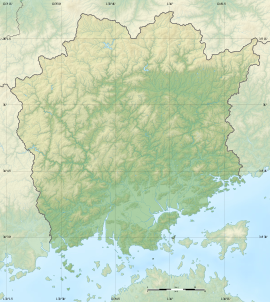Fukuyama Castle (Sōja)
| Fukuyama Castle | |
|---|---|
福山城 | |
Sōja, Okayama, Japan | |
 Mount Fukuyama | |
| Coordinates | 34°38′47.26″N 133°45′35.38″E / 34.6464611°N 133.7598278°E |
| Type | yamashiro-style Japanese castle |
| Site information | |
| Condition | ruins |
| Site history | |
| Built | 1335 |
| Built by | Shō Kanesuke |
| In use | 1336 |
| Battles/wars | Battle of Fukuyama (1336) |
Fukuyama Castle (福山城, Fukuyama-jō) of
History
Fukuyama Castle is located on Mount Fukuyama (elevation 302 meters) in the southern part of the city of Sōja. From the Nara period to the Kamakura period the mountain was occupied by a Buddhist temple called Fukusan-ji. In 1335, at the start of the Nanboku-chō period, the site was fortified by a local warlord, Shō Kanesuke, and entrusted to his retainer Makabe Korehisa. The castle consisted of three rings of fortifications and enclosures on the slopes of the mountain. This castle became the site of the "Battle of Fukuyama" as described in the Taiheiki.[2]
Battle of Fukuyama
In February 1336,
Present situation
At present, nothing remains of the castle except for remnants of earthworks, dry moats, wells, and fragments of stone walls of the castle gate.
See also
Literature
- De Lange, William (2021). An Encyclopedia of Japanese Castles. Groningen: Toyo Press. pp. 600 pages. ISBN 978-9492722300.
- Sansom, George (1961). A History of Japan: 1334–1615. Stanford, California: Stanford University Press
- Turnbull, Stephen (1998). The Samurai Sourcebook. London: Cassell & Co.
References
- ^ "福山城跡". Cultural Heritage Online (in Japanese). Agency for Cultural Affairs. Retrieved 25 December 2016.(in Japanese)
- ^ ISBN 4311750404.(in Japanese)
External links
![]() Media related to Fukuyama Castle (Bitchu) at Wikimedia Commons
Media related to Fukuyama Castle (Bitchu) at Wikimedia Commons
- Okayama Ancient Kibi Cultural Properties Center(in Japanese)
- Sōja city home page(in Japanese)


